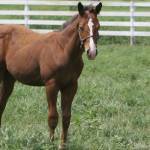Feeding the Foal after Weaning

Weaning is a stressful time for foals. While mares are often ready to say good-bye to their rowdy charges, foals can be far more fretful and often enter a growth slump immediately following weaning. Therefore, proper nutrition is paramount.
Foals are typically weaned at four to six months of age. Prior to weaning, the foal should be accustomed to eating solid feed. This is usually not a problem if the mare is being hard fed, as many foals are dipping into their dam’s feed bin by a few weeks of age. However, if the mare has maintained her condition on pasture and isn’t being hard fed, then the foal won’t be exposed to grain or pellets until weaning.
Some foals are introduced to creep feeding by two to three months of age, a time when milk production begins to decrease and often no longer fulfills the nutritional needs of the foal. Creep feeding serves two purposes: to guarantee the weanlings’ nutritional needs are being met, and to familiarize weanlings with eating grain so feeding time will be less stressful once separated from their dams.
How the foal is fed following weaning often depends greatly on what is expected of it in the following months. A weanling destined for the show or sale ring later in the year, for example, would be managed much more intensely than one being raised as a homebred performance prospect, where maximal growth and condition are not as imperative.
Regardless of their eventual use, the primary goal of feeding all weanlings is the same: steady, even growth. The KER growth evaluation computer program Gro-Trac can be used to monitor growth in young horses and provide early warning of changes in growth rate.
In order for the weanling to achieve optimal growth, sufficient dietary energy must be supplied. Weanlings generally cannot consume enough forage to satisfy energy requirements for steady growth at the rate needed by modern breeders. Therefore, grain must be fed. Approximately 0.5 kg (1 to 1.5 lb) of grain per day per month of age is recommended for weanlings of light horse breeds such as Thoroughbreds or Standardbreds. This can also be expressed as up to 1% of body weight. Pony or warmblood weanlings would receive less, about 0.2 to 0.3 kg (0.5 to 0.75 lb) per day per month of age.
The hard feeds should provide the energy, protein, and minerals necessary to compensate for those not present in the forage. In addition, the grain should have sufficient levels of lysine, an amino acid essential for proper growth. Grain mixes made with soybean meal or canola meal are preferred because of their high lysine content, and these meals are usually mixed in a pellet to ensure intake.
The requirement for lysine has been reinforced by research over the years. In one study, weanlings fed a diet with sufficient protein but insufficient lysine in the form of cottonseed meal experienced slower growth rates than peers fed cottonseed meal with added lysine or soybean meal as the protein supplements in the diet. Of course, most New Zealand pastures will supply a large proportion of the protein and amino acid needs, so hard feeds for weanlings and yearlings are designed with lower protein levels than in other countries.
A grain concentrate appropriate for a weanling on pasture will generally contain 14-16% crude protein. Feeding mild excesses of protein does not cause bone problems, as many people think it does. Higher protein feed concentrates containing minerals and vitamins that are fed at lower rates (e.g. 1 kg/d (2.2 lb)) can be used mixed with oats or other grains so the total grain mix supplies these levels of protein. In some breeds (e.g., warmbloods) and situations (e.g., high-quality pasture), a 1 kg (2.2 lb) balancer pellet is all that is required.
Adequate forage should be offered to make up for energy deficiencies between the weanling’s energy needs and that provided in the grain. The safest way to achieve this is by allowing the weanling access to all of the nonlegume forage it will consume. Feeding legume forage (clover or lucerne) is acceptable, but weanlings should not be allowed unrestricted access to it. Rather, they should be fed enough to provide sufficient digestible energy for moderate to rapid growth. Feeding too much legume forage is no different than feeding too much grain. Either way, excessive intake of dietary energy results.
Some researchers believe such feeding practices contribute to developmental orthopedic disease (DOD). If a legume forage, a legume-grass forage, or a very high-quality pasture is used, the amount of grain fed may be reduced to limit energy intake. A weanling normally fed 0.5 kg (1 lb) per month of age per day may be reduced to half that amount. In this case a more concentrated feed will be necessary to supply the mineral and vitamin needs in a smaller amount of feed. Like many adult horses, some weanlings are easy keepers and likely to become overweight on even minimal amounts of grain. In these cases, weanlings can be fed a low-calorie, low-intake source of essential protein, vitamins, and minerals, without feeding excessive energy.
The same situation may apply to weanlings that develop bone and joint disturbances such as physitis or osteochondritis, where the extra energy from grain is undesirable.
Once a group of weanlings is established on a suitable feeding program, there is no automatic need to increase it during winter or as the weanlings gets older. Usually an increase in appetite and forage intake can fulfill extra needs and maintain growth rate. Regular observation of condition or growth rate will determine whether grain intakes need to be increased or decreased
As with all horses, weanlings should have unlimited access to water and salt.
Nutritional mistakes made early in the lives of horses can lead to structural problems that may limit performance potential. Therefore, proper nutrition of the post-weaning foal is critical.








